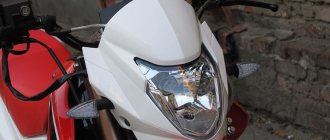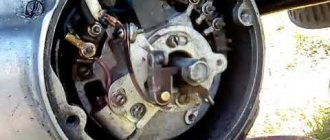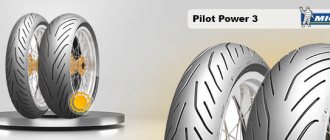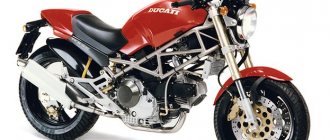All about motorcycles
Every beginning of the season promises the bursting of motorcycle service pipes. Owners of two-wheeled vehicles indignantly ask: “Why does the motorcycle stall or not start at all?” The answer to such questions is a number of tips on how to properly prepare for the cold and rainy season.
To avoid serious consequences in the fall, you need to rationally approach the issue of storing vehicles. Limiting the purchase of a cover will bring global problems, and the owner will end up losing a huge part of the budget and will spend a lot of nerves during repairs (or will have to replace the usual motorcycle with a new one).
Necessary measures
- Pre-wash and dry. After the motorcycle is washed, it is necessary to thoroughly wipe it with a rag and blow out the electrical connectors and all connections with compressed air.
- An oil change is necessary to ensure that the internal metal surfaces of the engine are not damaged by acid emissions that appear during the combustion process.
- There should be some fresh fuel mixed with stabilizer in the tank.
- The cylinders also need to be lubricated to prevent rust. Gasoline is a solvent; before cranking the starter, turn off the fuel and distribute the oil evenly among the cylinders.
- Remove the battery.
- Spray the frame, engine and other metal surfaces with a protective preservative liquid. It protects transport from moisture and temperature influences.
- Tires must be properly inflated.
- Spray the ends of the muffler and drain holes with WD-40.
All these actions are necessary if you want to “sit down and go” in the spring, and not bother with repairs for another couple of months.
Warm motorcycle storage in winter is the best thing that can happen to your bike
Seasonal storage of motorcycles is almost a ritual that must be carried out according to all sacred biker canons. How your iron friend spends the winter will greatly affect how it rides in the summer. If you don’t change the oil in the engine, it will answer you with an unkind cough in the spring. If you miss an oxidized contact in the wiring, expect sparkling light music throughout the motorcycle, which is unlikely to want to go anywhere in this condition. And the most expensive price you will pay is your spoiled mood at the very beginning of the season, when you see that the motorcycle is “no longer the same.” In other words, every little detail matters. Prepare your bike for winter storage so that in spring you'll be blowing away with the wind as soon as you step on the throttle. Fair wind!
Preparing for the “preservation” of the bike
Winters always promise frost and dampness, which is the first step to corrosion of the coatings of your motorcycle. Aluminum surfaces will oxidize, iron will rust permanently, and chrome will swell. The opinion that if it just sits in the garage all winter, nothing will happen to it, is wrong. The room must be dry and, preferably, heated, and the equipment must be prepared in accordance with all the rules .
So that the transport sparkles with newness in the spring and does not “sneeze” when driving :
- fill the plugs and connectors with silicone grease;
- inflate the wheels to 3 atmospheres (if you are storing them);
- sprinkle a drop of silicone grease into the keyholes;
- Apply a thick layer of the usual polishing liquid used by motorists on the plastic. No need to rinse off.
The best option for your peace of mind is special warehouses for storing equipment for the winter. But the concern for the serviceability of the vehicle is still always the responsibility of its owner.
On the street
The service life of any equipment when stored outside in winter is reduced. Leaving your motorcycle in wet or frosty weather is not recommended, but is likely.
Preliminary:
Apply wax polish to all surfaces.
Spray more water repellent on the seat and tires.
The vehicle must be on the center step. It is best to hang it so as not to strain the shock absorbers for several months.
The tank should be almost full of fuel. When exposed to sub-zero temperatures, the metal will shrink.
The exhaust hole must be plugged with a special plug or improvised means. No moisture can get in there.
The cover should not completely envelop the motorcycle. Need ventilation.
Power and reliability Ural retro Solo classic bike of the Soviet Union.
Maneuverable Ducati Monster 400, review of the Italian road motorcycle.
In a cold garage
When it is not possible to park your bike in a dry and warm room, a cold garage will do. Before leaving the vehicle to “winter,” you should complete all of the above steps. But, if in a warm room it is permissible to simply disconnect the battery, then in this case it must be removed and kept in any place with room temperature, or better on a glazed balcony. Charge periodically or fully charge before not using for a long period of time.
To avoid condensation, the tank must be full.
Although, gasoline loses its properties during prolonged stagnation. Modern touchless car wash will not work. It is best to wash the bike by hand with a special shampoo, rinse well and dry thoroughly.
If your motorcycle has a belt or driveshaft, there will be no problems. But the chain should be well lubricated. Rub chrome parts with a special paste after washing. This is not only beautiful, but also protects against the effects of chemical residues from shampoo.
If the garage is dry, then the leather coverings can be left as is. If not, spray with water-repellent liquid.
At the beginning of the new season, preparing transport for the first trip will not be difficult if all of the above has been taken into account.
Where is the best place to store a motorcycle?
Friends will say - a garage (yup, unheated), the mother-in-law will suggest a shed in the country, the wife will advise sending the bike to a paid parking lot, but all this is not the same. The best place to store a motorcycle in winter is a warm Attic storage area. Why are we so sure of this? Look at the benefits of winter motorcycle storage in a warm warehouse:
- constant temperature of +18 degrees Celsius at any time of the year;
- ventilation and cleaning consistently three times a week;
- complete security - 24-hour security and video surveillance around the entire perimeter of the warehouse without blind spots;
- delivery service.
Attic movers will come straight to your home and take your motorcycle to the warehouse, where it will be safely stored all winter. When the season comes, we will bring it back to anywhere in Moscow. All motorcycles in the Attic are stored in a separate area on pallets - we keep them warm, dry and happy.
Winter prices
The cost always varies. It all depends on the storage conditions, period and the company itself. When registering, an agreement is always drawn up and several documents and acts are required to be filled out. Basically, prices start from 1500 rubles. For large models the cost starts from 2800 rubles. for the entire season. Storage in a warm, protected box is better for the condition of the equipment and more reliable for the owner.
How to choose a children's mini motorcycle with gasoline, an overview of popular models.
Introduction to the Bobber style motorcycle, the main features of the classic design.
Lubrication of rubber elements
Now is the time to start lubricating the main rubber parts. We are primarily talking about oil seals, boots and cuffs of the fork and shock absorbers, which under the influence of frost can lose their silicone and crack. This threatens immediate failure of the fork and shock absorber, respectively. And if the output of the shock absorber may not be immediately noticed, then you will notice the consequences of leaked oil from the fork, which will inevitably end up on the brake discs and pads, the first time you try to stop. So, armed with silicone spray, you should carefully lubricate the above-mentioned parts, as well as the carburetor pipe, steering wheel vibration dampers, if any; brake hoses, rubber dampers of the driven star; cuffs of the main brake cylinders, as well as clutch cylinders. By and large, you have to lubricate everything rubber, except for tires, preparation for wintering of which can be limited to reducing the pressure to half the working pressure (usually up to 1 bar).
Photo gallery
Preserving motorcycle equipment for the winter, although not a complicated procedure, still requires due attention. In our small photo selection, we will look at how this is done in different parts of the world.
Disassembly and lubrication
| First you need to disconnect the terminals and remove the battery. Treat power wires and wiring with a moisture-displacing agent (WD-40) or silicone - this will protect them from oxidation. It is better to take the battery itself home and periodically perform a discharge-charge cycle. The next step is to thoroughly clean and lubricate the drive chain. Here, perhaps, we will do without detailed comments, hoping that you did this at least every thousand kilometers during the season. Next, you need to pour pre-prepared gasoline from a proven gas station into the gas tank “under the neck.” In such a way that as little air as possible remains under its lid. It would be a good idea to use a fuel stabilizer or medical alcohol - it will bind gasoline and water that somehow got into the gas tank during operation. This is all done to ensure that the walls of the gas tank do not rust from the inside. There is probably no need to tell you what rust that has accumulated for years in the gas tank will do to the carburetor or injectors. | The discharge and charge cycle is especially relevant for owners of new motorcycles, since most often they use lithium-polymer batteries, the complete discharge of which permanently disables them. |
| After completing these generally simple procedures, the most important thing remains to be done. For this you will need some motor oil and a syringe. So, we turn the spark plug out, fill a syringe with 5–20 ml of motor oil and inject it into the cylinder through the spark plug hole. It is important to take into account the volume of oil being poured: say, if you have a motorcycle with a single-cylinder 500 cc engine, for example a Yamaha SR500, then you will have to pour in 15 ml, and if, for example, a 500 cc V8 Moto Guzzi, then the total dose of the conventional 20 ml should be distribute equally into each of the eight cylinders. In order for the poured oil to reach its target, that is, to get into the gap between the piston rings and the piston, you need to rotate the crankshaft with an electric starter or with a kick. After this, the candles can be screwed back in. By the time the fuss with the candles is over, you'll almost certainly be running low on beer—it's time to call a friend and ask for more. In fact, the point is that his help will be required to complete the final stage of preservation of the patient. | This is all done so that the piston rings do not become tightly attached to the piston over the winter and you do not have to drag yourself to the service center in search of compression. |
Silicone treatment
Silicone grease will help prevent premature aging and wear of parts.
Parts that can be treated with silicone lubricants include:
- Rubber bands and seals;
- Wiring;
- Swivel joints;
- Pipes, cables and rods;
Treating tires with a special compound is also important. Neutral lubricant will protect the rubber from hardening, cracking, and aging.
The now fashionable leather panniers and seats of Enduro motorcycles can be protected with your choice of silicone, tire foam, or a special composition for leather - the result will be of equal quality. The same goes for equipment. The skin will not dry out or crack. But to process chrome parts you will need a separate compound.









